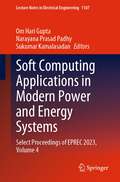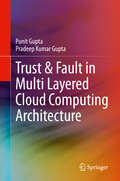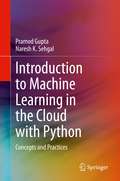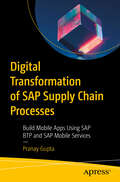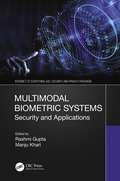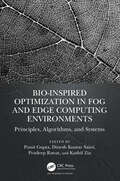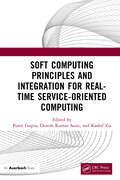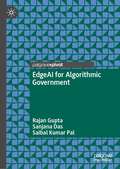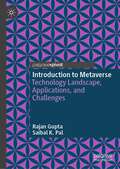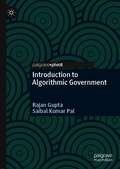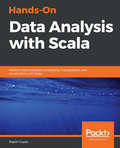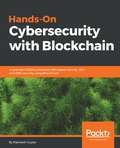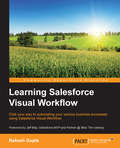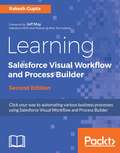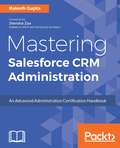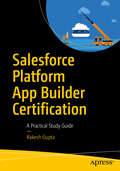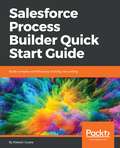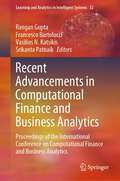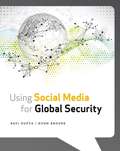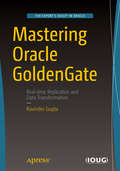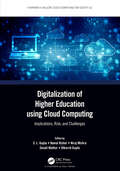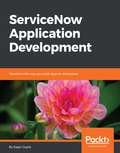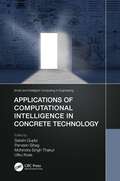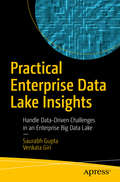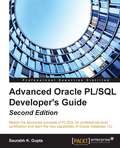- Table View
- List View
Soft Computing Applications in Modern Power and Energy Systems: Select Proceedings of EPREC 2023, Volume 4 (Lecture Notes in Electrical Engineering #1107)
by Om Hari Gupta Narayana Prasad Padhy Sukumar KamalasadanThis book includes select proceedings of EPREC 2023. It provides rigorous discussions, case studies, and recent developments in the areas of soft computing and its applications in power systems enabled with power electronics-based equipment, energy systems, and the energy community. The other topics to be covered are optimal planning, analysis, operation, and control related to modern power and energy systems, and applications of various soft computing methodologies. The readers find this book useful for enhancing their knowledge and skills in the domain areas.
Trust & Fault in Multi Layered Cloud Computing Architecture
by Pradeep Kumar Gupta Punit GuptaThis book discusses various aspects of cloud computing, in which trust and fault-tolerance models are included in a multilayered, cloud architecture. The authors present a variety of trust and fault models used in the cloud, comparing them based on their functionality and the layer in the cloud to which they respond. Various methods are discussed that can improve the performance of cloud architectures, in terms of trust and fault-tolerance, while providing better performance and quality of service to user. The discussion also includes new algorithms that overcome drawbacks of existing methods, using a performance matrix for each functionality. This book provide readers with an overview of cloud computing and how trust and faults in cloud datacenters affects the performance and quality of service assured to the users. Discusses fundamental issues related to trust and fault-tolerance in Cloud Computing;Describes trust and fault management techniques in multi layered cloud architecture to improve security, reliability and performance of the system;Includes methods to enhance power efficiency and network efficiency, using trust and fault based resource allocation.
Introduction to Machine Learning in the Cloud with Python: Concepts and Practices
by Pramod Gupta Naresh K. SehgalThis book provides an introduction to machine learning and cloud computing, both from a conceptual level, along with their usage with underlying infrastructure. The authors emphasize fundamentals and best practices for using AI and ML in a dynamic infrastructure with cloud computing and high security, preparing readers to select and make use of appropriate techniques. Important topics are demonstrated using real applications and case studies.
Digital Transformation of SAP Supply Chain Processes: Build Mobile Apps Using SAP BTP and SAP Mobile Services
by Pranay GuptaTake a high-level tour of SAP oDATA integrations with frontend technologies like Angular using the SAP Mobile Services Platform. This book will give you a different perspective on executing SAP transactions on iOS using Angular instead of SAP-provided Fiori-based applications. You’ll start by learning about SAP supply chain processes such as Goods Receipt, Transfer Posting, Goods Issue, and Inventory Search. You’ll then move on to understanding the thought process involved in integrating SAP's backend (SAP ECC) with Angular iOS app using SAP Mobile Services running on SAP BTP. All this will serve as a guide tailored to SAP functional and technical consultants actively engaged in client-facing roles. You’ll follow a roadmap for modernizing and streamlining supply chain operations by leveraging Angular iOS apps. Digital Transformation of SAP Supply Chain Processes provides the essential tools for businesses looking to stay competitive in today's technology-driven landscape. What You Will Learn Study the fundamental procedures to set up the Authorization Endpoint, Token Endpoint, and base URL within SAP Mobile Services.Manage attachments in mobile applications and store them in an external content repository. Gain proficiency in testing OData services using the POSTMAN API client with OAuth protocol.Acquire knowledge about the JSON messages, CORS protocol, and X-CSRF token exchange.Link Zebra Printers through the Zebra Native Printing app on iOS App to print SAP forms on mobile printers. Who This Book Is For SAP Consultants with an interest in the Digital Transformation of SAP Supply Chain Processes to iOS-based SAP transactions.
Multimodal Biometric Systems: Security and Applications (Internet of Everything (IoE))
by Prof. Dr. Rashmi Gupta Dr Manju KhariMany governments around the world are calling for the use of biometric systems to provide crucial societal functions, consequently making it an urgent area for action. The current performance of some biometric systems in terms of their error rates, robustness, and system security may prove to be inadequate for large-scale applications to process millions of users at a high rate of throughput. This book focuses on fusion in biometric systems. It discusses the present level, the limitations, and proposed methods to improve performance. It describes the fundamental concepts, current research, and security-related issues. The book will present a computational perspective, identify challenges, and cover new problem-solving strategies, offering solved problems and case studies to help with reader comprehension and deep understanding. This book is written for researchers, practitioners, both undergraduate and post-graduate students, and those working in various engineering fields such as Systems Engineering, Computer Science, Information Technology, Electronics, and Communications.
Bio-Inspired Optimization in Fog and Edge Computing Environments: Principles, Algorithms, and Systems
by Punit Gupta Dinesh Kumar Saini Pradeep Singh Rawat Kashif ZiaA new era of complexity science is emerging, in which nature- and bio-inspired principles are being applied to provide solutions. At the same time, the complexity of systems is increasing due to such models like the Internet of Things (IoT) and fog computing. Will complexity science, applying the principles of nature, be able to tackle the challenges posed by highly complex networked systems? Bio-Inspired Optimization in Fog and Edge Computing: Principles, Algorithms, and Systems is an attempt to answer this question. It presents innovative, bio-inspired solutions for fog and edge computing and highlights the role of machine learning and informatics. Nature- or biological-inspired techniques are successful tools to understand and analyze a collective behavior. As this book demonstrates, algorithms, and mechanisms of self-organization of complex natural systems have been used to solve optimization problems, particularly in complex systems that are adaptive, ever-evolving, and distributed in nature. The chapters look at ways of enhancingto enhance the performance of fog networks in real-world applications using nature-based optimization techniques. They discuss challenges and provide solutions to the concerns of security, privacy, and power consumption in cloud data center nodes and fog computing networks. The book also examines how: The existing fog and edge architecture is used to provide solutions to future challenges. A geographical information system (GIS) can be used with fog computing to help users in an urban region access prime healthcare. An optimization framework helps in cloud resource management. Fog computing can improve the quality, quantity, long-term viability, and cost-effectiveness in agricultural production. Virtualization can support fog computing, increase resources to be allocated, and be applied to different network layers. The combination of fog computing and IoT or cloud computing can help healthcare workers predict and analyze diseases in patients.
Soft Computing Principles and Integration for Real-Time Service-Oriented Computing
by Punit Gupta Dinesh Kumar Saini Kashif ZiaIn recent years, soft computing techniques have emerged as a successful tool to understand and analyze the collective behavior of service- oriented computing software. Algorithms and mechanisms of self- organization of complex natural systems have been used to solve problems, particularly in complex systems, which are adaptive, ever- evolving, and distributed in nature across the globe. What fits more perfectly into this scenario other than the rapidly developing era of Fog, IoT, and Edge computing environment? Service- oriented computing can be enhanced with soft computing techniques embedded inside the Cloud, Fog, and IoT systems.Soft Computing Principles and Integration for Real-Time Service-Oriented Computing explores soft computing techniques that have wide application in interdisciplinary areas. These soft computing techniques provide an optimal solution to the optimization problem using single or multiple objectives.The book focuses on basic design principles and analysis of soft computing techniques. It discusses how soft computing techniques can be used to improve quality-of-service in serviceoriented architectures. The book also covers applications and integration of soft computing techniques with a service- oriented computing paradigm. Highlights of the book include: A general introduction to soft computing An extensive literature study of soft computing techniques and emerging trends Soft computing techniques based on the principles of artificial intelligence, fuzzy logic, and neural networks The implementation of SOC with a focus on service composition and orchestration, quality of service (QoS) considerations, security and privacy concerns, governance challenges, and the integration of legacy systems The applications of soft computing in adaptive service composition, intelligent service recommendation, fault detection and diagnosis, SLA management, and security Such principles underlying SOC as loose coupling, reusability, interoperability, and abstraction An IoT based framework for real time data collection and analysis using soft computing
EdgeAI for Algorithmic Government
by Rajan Gupta Sanjana Das Saibal Kumar PalThe book provides various EdgeAI concepts related to its architecture, key performance indicators, and enabling technologies after introducing algorithmic government, large-scale decision-making, and computing issues in the cloud and fog. With advancements in technology, artificial intelligence has permeated our personal lives and the fields of economy, socio-culture, and politics. The integration of artificial intelligence (AI) into decision-making for public services is changing how governments operate worldwide. This book discusses how algorithms help the government in various ways, including virtual assistants for busy civil servants, automated public services, and algorithmic decision-making processes. In such cases, the implementation of algorithms will occur on a massive scale and possibly affect the lives of entire communities. The cloud-centric architecture of artificial intelligence brings out challenges of latency, overhead communication, and significant privacy risks. Due to the sheer volume of data generated by IoT devices, the data analysis must be performed at the forefront of the network. This introduces the need for edge computing in algorithmic government. EdgeAI, the confluence of edge computing and AI, is the primary focus of this book. It also discusses how one can incorporate these concepts in algorithmic government through conceptual framework and decision points. Finally, the research work emphasizes some design challenges in edge computing from applications viewpoint. This book will be helpful for data engineers, data scientists, cloud engineers, data management experts, public policymakers, administrators, research scholars and academicians.
Introduction to Metaverse: Technology Landscape, Applications, and Challenges
by Rajan Gupta Saibal K. PalThis book discusses Metaverse Technology, which is one of the emerging technologies around the world, through its concepts, definitions, architectural layers, economic implications, and presents comparison points with other allied areas like Web 3.0, Digital Twin, Blockchain, Multiverse, Artificial Intelligence, Internet of Everything and Hyperautomation.The book also presents several use-cases and adoption areas of Metaverse technology, along with global outlook of top companies implementing this technology through major platforms and tools. The potential use of this technology for Public Sector is also explored in this book, apart from the suggested business framework for its adoption. Potential misuse and ethical concerns have also been summarised. This introductory book on Metaverse, written with a multidisciplinary approach, will provide readers with a clear understanding of what the Metaverse is, what technologies are involved in its creation, and its current as well as potential future applications, in a very simple manner.
Introduction to Algorithmic Government
by Rajan Gupta Saibal Kumar PalThe world is changing at a fast pace, so is the Government and Governance style. Humans are bound to go for Algorithmic strategies rather than manual or electronic ones in different domains. This book introduces the Algorithmic Government or Government by Algorithm, which refers to authorizing machines in the Public Sector for automated decision-making based on Artificial Intelligence, Data Science, and other technologies. It is an emerging concept introduced globally and will be considered revolutionary in the future. The book covers concepts, applications, progress status, and potential use-cases of Algorithmic Government. This book serves as introductory material for the readers from technology, public policy, administration, and management fields.
Hands-On Data Analysis with Scala: Perform data collection, processing, manipulation, and visualization with Scala
by Rajesh GuptaMaster scala's advanced techniques to solve real-world problems in data analysis and gain valuable insights from your dataKey FeaturesA beginner's guide for performing data analysis loaded with numerous rich, practical examplesAccess to popular Scala libraries such as Breeze, Saddle for efficient data manipulation and exploratory analysisDevelop applications in Scala for real-time analysis and machine learning in Apache SparkBook DescriptionEfficient business decisions with an accurate sense of business data helps in delivering better performance across products and services. This book helps you to leverage the popular Scala libraries and tools for performing core data analysis tasks with ease.The book begins with a quick overview of the building blocks of a standard data analysis process. You will learn to perform basic tasks like Extraction, Staging, Validation, Cleaning, and Shaping of datasets. You will later deep dive into the data exploration and visualization areas of the data analysis life cycle. You will make use of popular Scala libraries like Saddle, Breeze, Vegas, and PredictionIO for processing your datasets. You will learn statistical methods for deriving meaningful insights from data. You will also learn to create applications for Apache Spark 2.x on complex data analysis, in real-time. You will discover traditional machine learning techniques for doing data analysis. Furthermore, you will also be introduced to neural networks and deep learning from a data analysis standpoint.By the end of this book, you will be capable of handling large sets of structured and unstructured data, perform exploratory analysis, and building efficient Scala applications for discovering and delivering insightsWhat you will learnTechniques to determine the validity and confidence level of dataApply quartiles and n-tiles to datasets to see how data is distributed into many bucketsCreate data pipelines that combine multiple data lifecycle stepsUse built-in features to gain a deeper understanding of the dataApply Lasso regression analysis method to your dataCompare Apache Spark API with traditional Apache Spark data analysisWho this book is forIf you are a data scientist or a data analyst who wants to learn how to perform data analysis using Scala, this book is for you. All you need is knowledge of the basic fundamentals of Scala programming.
Hands-On Cybersecurity with Blockchain: Implement DDoS protection, PKI-based identity, 2FA, and DNS security using Blockchain
by Rajneesh GuptaDevelop blockchain application with step-by-step instructions, working example and helpful recommendationsKey Features● Understanding the blockchain technology from the cybersecurity perspective● Developing cyber security solutions with Ethereum blockchain technology● Understanding real-world deployment of blockchain based applicationsBook DescriptionBlockchain technology is being welcomed as one of the most revolutionary and impactful innovations of today. Blockchain technology was first identified in the world’s most popular digital currency, Bitcoin, but has now changed the outlook of several organizations and empowered them to use it even for storage and transfer of value.This book will start by introducing you to the common cyberthreat landscape and common attacks such as malware, phishing, insider threats, and DDoS. The next set of chapters will help you to understand the workings of Blockchain technology, Ethereum and Hyperledger architecture and how they fit into the cybersecurity ecosystem. These chapters will also help you to write your first distributed application on Ethereum Blockchain and the Hyperledger Fabric framework. Later, you will learn about the security triad and its adaptation with Blockchain. The last set of chapters will take you through the core concepts of cybersecurity, such as DDoS protection, PKI-based identity, 2FA, and DNS security. You will learn how Blockchain plays a crucial role in transforming cybersecurity solutions.Toward the end of the book, you will also encounter some real-world deployment examples of Blockchain in security cases, and also understand the short-term challenges and future of cybersecurity with Blockchain.What you will learn● Understand the cyberthreat landscape● Learn about Ethereum and Hyperledger Blockchain● Program Blockchain solutions● Build Blockchain-based apps for 2FA, and DDoS protection● Develop Blockchain-based PKI solutions and apps for storing DNS entries● Challenges and the future of cybersecurity and BlockchainWho this book is forThe book is targeted towards security professionals, or any stakeholder dealing with cybersecurity who wants to understand the next-level of securing infrastructure using Blockchain. Basic understanding of Blockchain can be an added advantage.
Learning Salesforce Visual Workflow
by Rakesh GuptaLearning Salesforce Visual Workflow is intended for those who want to use Flows to automate their business requirements by click not code. Salesforce maintains an incredibly user-friendly interface; no previous experience in computer coding or programming is required.
Learning Salesforce Visual Workflow and Process Builder - Second Edition
by Rakesh GuptaClick your way to automating various business processes using Salesforce Visual Workflow About This Book • Develop an application using Point and Click with the help of Flow • Get to grips with various ways to launch a Flow • Capture data from an external user without using the Visualforce page • Save user input into the database, and learn how to query and manipulate the data • Discover various ways to debug and deploy Flow and Process Builder • Understand the concepts of Subflow and Login Flow • Handle complex business processes using Process builder and keep them clean • Use existing or new Flows to work with Salesforce Lightning Experience. Who This Book Is For This book is intended for those who want to use Flows to automate their business requirements by clicking, not coding. No previous experience in computer coding or programming is required. What You Will Learn • Develop an application using point and click with the help of Flow • Get to grips with various ways to launch a Flow • Capture data from an external user without using the Visualforce page • Save user input into the database, and learn how to query and manipulate the data • Discover various ways to debug and deploy Flow and Process Builder • Understand the concepts of Subflow and Login Flow • Handle complex business processes using Process builder and keep them clean • Use existing or new Flows to work with Salesforce Lightning Experience. In Detail Salesforce Management System is an information system used in CRM to automate the business processes like sales and marketing. To implement this, Force.com developed a powerful tool called Visual Workflow to automate business processes by creating applications also called Flows. Learning Salesforce Visual Workflow, Second Edition is a practical guide on Flows that will enable you to develop custom applications in Salesforce with minimized code usage. The book starts with an introduction to Visual Workflows that teaches all the building blocks of creating Flows and use it efficiently. You will learn how to easily automate business processes and tackle complex business scenarios using Flows. The book explains the working of the Process Builder so you can create reusable processes. The book also covers how you can integrate existing or newly created Flows with the Salesforce Lightening Experience. By the end of the book, you will get a clear understanding on how to use Flows and Process Builder in your organization to optimize code usage. Style and approach Step by step approch to use Process Builder to solve complex business requirements with the help of Flow
Mastering Salesforce CRM Administration
by Rakesh GuptaLearn about the Advanced Administration Certification Examination and build a successful career in Salesforce administration About This Book • Build your skills and knowledge to crack the Advanced Admin Certification Examination • Leverage the advanced administration capabilities of Salesforce and Salesforce1 • Optimize and extend Sales Cloud and Service Cloud applications Who This Book Is For This book is written for Salesforce admins who are looking to gain an in-depth knowledge of the Salesforce platform and grow their value in their organization. It will teach them to implement and design advanced business process automation for the benefit of their organization. What You Will Learn • Adopt Lightning Experience to improve the productivity of your organization's sales team • Create and maintain service entitlements and entitlement processes • Process Builder basic and advanced concepts • Different ways to deploy applications between environments • Best practices for improving and enriching data quality In Detail The book starts by refreshing your knowledge of common admin tasks. You will go over Lightning Experience and various security aspects. You will be shown how to implement territory management in your organization and make use of custom objects. From here, the book progresses to advanced configuration, data management, and data analytics before swiftly moving on to setting up advanced organization-wide features that affect the look and feel of the application. Extend the capabilities of your organization's Salesforce implementation by optimizing and extending Sales Cloud, Salesforce1, and Service Cloud applications. This guide will equip you with the tools you need to build a successful career in Salesforce. Style and approach The book takes a straightforward, no-nonsense approach to working with the Salesforce CRM platform. It is filled with examples, advanced use cases, and all the resources you need to be a Salesforce Jedi.
Salesforce Platform App Builder Certification: A Practical Study Guide
by Rakesh GuptaNew or intermediate developers will want to use this hands-on guide to prepare for the Salesforce Certified Platform App Builder credential, awarded for designing, building, and implementing applications using the declarative customization capabilities of the Salesforce Platform. This is the first book available covering this content, and Salesforce training is very costly. This book is filled with real-world examples and hands-on exercises, enabling you to prepare for the certification exam in a short span of time. Multiple-choice study questions and exercises are included to help you apply what you learn in each chapter.Author Rakesh Gupta explains Salesforce Platform fundamentals, including knowledge about the limitations of the declarative platform and when to use programmatic development versus the AppExchange. Data management and data analytics are covered. And you will learn how to set up organization-wide features that affect the look and feel of your application. Sandbox design patterns and process automation tools available in Salesforce are discussed and you will know when to use them. You will become familiar with a wide array of topics, including designing a mobile app and reporting in Salesforce. What You Will Learn Know when to use declarative development versus programmatic development versus the AppExchangeUnderstand the Salesforce data model, field type (when to use which fields), and how and when to use an external object in SalesforceBe familiar with security and settings in SalesforceSee how easily users can migrate to the Lightning experience from the classic platformImplement business process automation using declarative featuresApply the automation process in SalesforceUtilize Process Builder and manage its power to automate business processesUse sandboxes and deployment tools Who This Book Is For New or intermediate Salesforce developers or anyone in the Salesforce development arena who wants to learn or explore the platform
Salesforce Process Builder Quick Start Guide: Build complex workflows by clicking, not coding
by Rakesh GuptaClick your way to automating business processes with Salesforce Visual WorkflowKey FeaturesCreate and maintain complex business processes using Process builderDiscover how to debug and deploy Flow and Process BuilderUse new or existing Flows to work with Salesforce Lightning ExperienceBook DescriptionSalesforce Management System is an information system used in CRM to automate business processes, such as sales and marketing. Process Builder is a visual tool created to automate business processes in Salesforce. It enables users with no coding expertise to build complex Salesforce workflows.The book starts with an introduction to Process Builder, focussing on the building blocks of creating Processes. Then you will learn about different applications of Process Builder for developing streamlined solutions. You will learn how to easily automate business processes and tackle complex business scenarios using Processes. The book explains the workings of the Process Builder so that you can create reusable processes. It also explains how you can migrate existing Workflow Rules to Process Builder.By the end of the book, you will have a clear understanding of how to use Flows and Process Builder to optimize code usage.What you will learnDevelop an application using point and click with the help of Process BuilderBypass Processes for specific usersUnderstand the concepts of reusable processesHandle complex business processes using Process Builder and keep them cleanWork with formulae in Process Builder to minimize the code requiredCreate a process with no criteria so as to minimize the amount of reworkOvercome Salesforce's known limitation in terms of referencing picklist valuesWho this book is forThis book is for people who want to use Process Builder to automate their business requirements by clicking, not coding. A basic understanding of Salesforce is required, but not extensive programming knowledge.
Recent Advancements in Computational Finance and Business Analytics: Proceedings of the International Conference on Computational Finance and Business Analytics (Learning and Analytics in Intelligent Systems #32)
by Rangan Gupta Francesco Bartolucci Vasilios N. Katsikis Srikanta PatnaikRecent Advancements of Computational Finance and Business Analytics provide a comprehensive overview of the cutting-edge advancements in this dynamic field. By embracing computational finance and business analytics, organizations can gain a competitive edge in an increasingly data-driven and complex business environment.This book has explored the latest developments and breakthroughs in this rapidly evolving domain, providing a comprehensive overview of the current state of computational finance and business analytics. It covers the following dimensions of this domains:Business AnalyticsFinancial AnalyticsHuman Resource AnalyticsMarketing Analytics
Using Social Media for Global Security
by Ravi Gupta Hugh BrooksEssential reading for cybersecurity professionals, security analysts, policy experts, decision-makers, activists, and law enforcement!During the Arab Spring movements, the world witnessed the power of social media to dramatically shape events. Now this timely book shows government decision-makers, security analysts, and activists how to use the social world to improve security locally, nationally, and globally--and cost-effectively. Authored by two technology/behavior/security professionals, Using Social Media for Global Security offers pages of instruction and detail on cutting-edge social media technologies, analyzing social media data, and building crowdsourcing platforms.The book teaches how to collect social media data and analyze it to map the social networks of terrorists and sex traffickers, and forecast attacks and famines. You will learn how to coalesce communities through social media to help catch murderers, coordinate disaster relief, and collect intelligence about drug smuggling from hard-to-reach areas. Also highlighting dramatic case studies drawn from the headlines, this crucial book is a must-read.Illustrates linguistic, correlative, and network analysis of OSINTExamines using crowdsourcing technologies to work and engage with populations globally to solve security problemsExplores how to ethically deal with social media data without compromising people's rights to privacy and freedom of expressionShows activists fighting against oppressive regimes how they can protect their identities onlineIf you're responsible for maintaining local, national or global security, you'll want to read Using Social Media for Global Security.
Mastering Oracle GoldenGate
by Ravinder GuptaMaster Oracle GoldenGate technology on multiple database platforms using this step-by-step implementation guide. Learn about advanced features to use in building a robust, high-availability replication system. Provided are detailed illustration of Oracle GoldenGate concepts, GoldenGate tools and add-ons, as well as illustrative examples. The book covers Oracle GoldenGate for Oracle database, and also discusses setup and configuration for other common databases such as IBM DB2, SYBASE ASE, MySQL, and Microsoft SQL Server. The technology landscape is fast-changing, and Mastering Oracle GoldenGate stays current by covering the new features included in Oracle GoldenGate 12c. The book covers both classic capture and integrated capture, as well as delivery. Also covered are Oracle GoldenGate security and performance tuning, to keep your system secure and performing at its best. You will learn to monitor your GoldenGate system using tools that come with Oracle GoldenGate management pack, as well as using shell scripts. Troubleshooting is well-illustrated with examples: Covering Oracle GoldenGate technology across common database brands Discussing high-performing and secure replication environments Speaking to replication in Big Data and cloud computing environments What You Will Learn Implement Oracle GoldenGate for real time replication Secure and tune your replication environment for high performance Administer your Oracle GoldenGate environment Learn troubleshooting approaches with help of examples Make use of GoldenGate Management Pack and its API Feed live data into Big Data and cloud-based systems Who This Book Is For Database professionals who have chosen to ride the Oracle GoldenGate roller coaster for real-time replication solutions. The book is for beginners as well as professionals who are willing to master the leading replication technology in the industry. It is an excellent choice for professionals who are implementing or maintaining Oracle GoldenGate replication environments on any of the major database management system platforms.
Digitalization of Higher Education using Cloud Computing: Implications, Risk, and Challenges (Chapman & Hall/CRC Cloud Computing for Society 5.0)
by S. L. GuptaDigitalization of Higher Education using Cloud Computing: Implications, Risk, and Challenges provides an insight into the latest technology and tools being used to explore learning in Higher Educational Institutions (HEIs). Cloud computing, being an up-and-coming technology, integrates with academia and industry, thereby enhancing the quality of education. The opportunities and challenges faced by HEIs in recent times due to technological disruptions have forced both academia and industry to realign their strategies for survival and growth. With the acceleration of cloud computing in higher education, it has now become imperative for educators to constantly upskill and reskill in order to meet the requirements of the future of work, particularly in the digital age. Technological advancement is an unstoppable wave and the lack of relevant skills to handle the disruptions in higher education will become a huge challenge if not addressed promptly. This is the new phase of Education 4.0 where HEIs are aligning themselves using cloud computing implications, and thus are preparing both faculties and students to embrace the changes happening in the teaching and learning processes. This book focuses on multi-faceted strategies to be adopted by HEIs to deal with the emerging issues related to teaching–learning processes using cloud computing, technological interventions, curriculum overhaul, experiential learning, multi-disciplinary approaches, and continuous innovations and digitalization. The book offers comprehensive coverage of many academic areas, with the most essential topics including: • Pedagogies in digital education using a cloud environment • Risks and challenges in cloud platforms for teaching and learning • Collaborative and group learning in a cloud environment • Enhancing quality of education using e-learning methodologies The sections in this book are "Cloud Enabled Digitalization of Higher Education" and "Innovations and Applications of Digitalization of Higher Education: A Cloud Perspective". The book will be useful for undergraduates, graduates, academicians, scholars, and policy makers. It will help readers acquire skills for a smooth transition from face-to-face teaching to cloud-based teaching.
ServiceNow Application Development
by Sagar GuptaDevelop and extend efficient cloud-native applications with ServiceNow About This Book • Build and customize your apps and workflows to suit your organization's requirements • Perform in-depth application development from designing forms to writing business rules, client-scripts, and workflows • Comprehensive guide to the end-to-end implementation of designing and extending apps with ServiceNow Who This Book Is For If you are a ServiceNow administrator and developer and need to build and customize your service management solution (apps and workflows) with ServiceNow, then this book is for you. What You Will Learn • Customize the ServiceNow dashboard to meet your business requirements • Use Administration and Security Controls to add roles and ensure proper access • Manage tables and columns using data dictionaries • Learn how application scopes are defined within ServiceNow • Configure different types of table to design your application • Start using the different types of scripting options available in ServiceNow • Design and create workflows for task tables • Use debugging techniques available in ServiceNow to easily resolve script-related issues • Run scripts at regular time intervals using the Scheduled Script Execution module In Detail ServiceNow provides service management for every department in the enterprise, including IT, Human Resources, Facilities, Field Service, and more. This book focuses on all the steps required to develop apps and workflows for any of your business requirements using ServiceNow. You will start with the first module, which covers the basics of ServiceNow and how applications are structured; how you can customize the dashboard as required; and also how to create users. After you get used to the dashboard, you will move on to the next module, Applications and Tables, where you will learn about working with different tables and how you can create a scope other than the global scope for your application. The next module is Scripting and APIs, where you will learn Scripting in ServiceNow and use powerful APIs to develop applications. The final module, Administration Essentials, covers debugging, advanced database features, and scheduled script creation. By the end of the book you will have mastered creating organized and customer-friendly applications Style and approach A step-by-step tutorial to designing applications and workflows with ServiceNow
Applications of Computational Intelligence in Concrete Technology (Smart and Intelligent Computing in Engineering)
by Sakshi GuptaComputational intelligence (CI) in concrete technology has not yet been fully explored worldwide because of some limitations in data sets. This book discusses the selection and separation of data sets, performance evaluation parameters for different types of concrete and related materials, and sensitivity analysis related to various CI techniques. Fundamental concepts and essential analysis for CI techniques such as artificial neural network, fuzzy system, support vector machine, and how they work together for resolving real-life problems, are explained. Features: It is the first book on this fast-growing research field. It discusses the use of various computation intelligence techniques in concrete technology applications. It explains the effectiveness of the methods used and the wide range of available techniques. It integrates a wide range of disciplines from civil engineering, construction technology, and concrete technology to computation intelligence, soft computing, data science, computer science, and so on. It brings together the experiences of contributors from around the world who are doing research in this field and explores the different aspects of their research. The technical content included is beneficial for researchers as well as practicing engineers in the concrete and construction industry.
Practical Enterprise Data Lake Insights: Handle Data-Driven Challenges in an Enterprise Big Data Lake
by Saurabh Gupta Venkata GiriUse this practical guide to successfully handle the challenges encountered when designing an enterprise data lake and learn industry best practices to resolve issues.When designing an enterprise data lake you often hit a roadblock when you must leave the comfort of the relational world and learn the nuances of handling non-relational data. Starting from sourcing data into the Hadoop ecosystem, you will go through stages that can bring up tough questions such as data processing, data querying, and security. Concepts such as change data capture and data streaming are covered. The book takes an end-to-end solution approach in a data lake environment that includes data security, high availability, data processing, data streaming, and more.Each chapter includes application of a concept, code snippets, and use case demonstrations to provide you with a practical approach. You will learn the concept, scope, application, and starting point.What You'll LearnGet to know data lake architecture and design principlesImplement data capture and streaming strategiesImplement data processing strategies in HadoopUnderstand the data lake security framework and availability modelWho This Book Is ForBig data architects and solution architects
Advanced Oracle PL/SQL Developer's Guide - Second Edition
by Saurabh K. GuptaMaster the advanced concepts of PL/SQL for professional-level certification and learn the new capabilities of Oracle Database 12c About This Book * Learn advanced application development features of Oracle Database 12c and prepare for the 1Z0-146 examination * Build robust and secure applications in Oracle PL/SQL using the best practices * Packed with feature demonstrations and illustrations that will help you learn and understand the enhanced capabilities of Oracle Database 12c Who This Book Is For This book is for Oracle developers responsible for database management. Readers are expected to have basic knowledge of Oracle Database and the fundamentals of PL/SQL programming. Certification aspirants can use this book to prepare for 1Z0-146 examination in order to be an Oracle Certified Professional in Advanced PL/SQL. What You Will Learn * Learn and understand the key SQL and PL/SQL features of Oracle Database 12c * Understand the new Multitenant architecture and Database In-Memory option of Oracle Database 12c * Know more about the advanced concepts of the Oracle PL/SQL language such as external procedures, securing data using Virtual Private Database (VPD), SecureFiles, and PL/SQL code tracing and profiling * Implement Virtual Private Databases to prevent unauthorized data access * Trace, analyze, profile, and debug PL/SQL code while developing database applications * Integrate the new application development features of Oracle Database 12c with the current concepts * Discover techniques to analyze and maintain PL/SQL code * Get acquainted with the best practices of writing PL/SQL code and develop secure applications In Detail Oracle Database is one of the most popular databases and allows users to make efficient use of their resources and to enhance service levels while reducing the IT costs incurred. Oracle Database is sometimes compared with Microsoft SQL Server, however, Oracle Database clearly supersedes SQL server in terms of high availability and addressing planned and unplanned downtime. Oracle PL/SQL provides a rich platform for application developers to code and build scalable database applications and introduces multiple new features and enhancements to improve development experience. Advanced Oracle PL/SQL Developer's Guide, Second Edition is a handy technical reference for seasoned professionals in the database development space. This book starts with a refresher of fundamental concepts of PL/SQL, such as anonymous block, subprograms, and exceptions, and prepares you for the upcoming advanced concepts. The next chapter introduces you to the new features of Oracle Database 12c, not limited to PL/SQL. In this chapter, you will understand some of the most talked about features such as Multitenant and Database In-Memory. Moving forward, each chapter introduces advanced concepts with the help of demonstrations, and provides you with the latest update from Oracle Database 12c context. This helps you to visualize the pre- and post-applications of a feature over the database releases. By the end of this book, you will have become an expert in PL/SQL programming and will be able to implement advanced concepts of PL/SQL for efficient management of Oracle Database. Style and approach The book follows the structure of the Oracle Certification examination but doesn't restrict itself to the exam objectives. Advanced concepts have been explained in an easy-to-understand style, supported with feature demonstrations and case illustrations.
